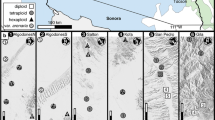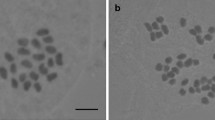Abstract
The ploidy level of plants of theVaccinium sect.Oxycoccus (Hill)W.D.J. Koch sampled in the Czech Republic, Germany, Austria and Poland was determined by chromosome counting and/or by flow cytometry. Forty-five characters were measured and scored in the morphometric analysis. Principal component analysis, cluster analysis, canonical discriminant analysis and classificatory discriminant analysis were used in the statistical analyses.
Diploid (2n=24), tetraploid (2n=48) and hexaploid (2n=72) populations were confirmed and a new ploidy level — pentaploid hybrid plants (2n=60) — was revealed. Results of the multivariate morphometric analysis support the separation of the two native species. DiploidV. microcarpum (Turcz. exRupr.)Schmalh. differs from the polyploids by smaller size of petals, shorter style and stamens (stamens have long filaments and short anthers), glabrous pedicels, mostly solitary flowers, earlier flowering and by occurrence predominantly inPolytrichum strictum tufts. The low taxonomic significance of some features often used in keys for their separation (shape of fruits, insertion of prophylla, pubescence of filaments) was confirmed.V. oxycoccos L. includes three ploidy levels. The hexaploids represent the most abundant ploidy level in the area studied. They show a slightly bigger size of petals, longer bracts, prophylla, style, sepal tips and wider seeds in comparison with the tetraploids. Pentaploid cranberries are hitherto known only from the Czech Republic. They differ particularly in the low proportion of fully-developed tetrads.
Similar content being viewed by others
References
Ahokas H. (1971a): Cytology of hexaploid cranberry with special reference to chromosomal fibres.Hereditas 68: 123–136.
Ahokas H. (1971b): Notes on polyploidy and hybridity inVaccinium species.Ann. Bot. Fenn. 8: 254–256.
Ahokas H. (1996): Is the polyploid cranberry (Vaccinium sp.) in Finland tetraploid or hexaploid?Nord. J. Bot. 16: 185–189.
Baumgarten J.C.G. (1816):Enumeratio stirpium magno transsilvaniae principatui. Vindobona.
Bretagnolle F. &Thompson J.D. (1995): Gametes with the somatic chromosome number: mechanisms of their formation and role in the evolution of autopolyploid plants.New Phytol. 129: 1–22.
Camp W.H. (1944): A preliminary consideration of the biosystematy ofOxycoccus.Bull. Torrey Bot. Club 71: 426–437.
Costich D.E., Ortiz R., Meagher T.R., Bruederle L.P. &Vorsa N. (1993): Determination of ploidy level and nuclear DNA content in blueberry by flow cytometry.Theor. Appl. Genet. 86: 1001–1006.
Čvančcara A. (1990):VacciniaceaeS.F. Gray. In:HejnýS. &SlavíkB. et al. (eds.),Květena ČR 2, Academia, Praha, pp. 503–508.
Darrow G.M., Camp W.H. Fischer H.E. &Dermen H. (1944): Chromosome numbers inVaccinium and related groups.Bull. Torrey Bot. Club 71: 498–506.
Dayton W.A. (1938): A cranberry from the Tahoe national forest.Madroño 4: 201–203.
Doležel J. (1997): Application of flow cytometry for the study of plant genomes.J. Appl. Genet. 38: 282–302.
Duty J. (1960): Floristische Beiträge zur geobotanischen Geländearbeit in Mitteldeutschland (V). 2.Oxycoccus macrocarpusPers., 3.Oxycoccus microcarpusTurcz.Wiss. Z. Martin-Luther-Univ. Halle-Wittenberg 9: 419–420.
Dweikat I.M. &Lyrene P. M. (1988): Production and viability of unreduced gametes in triploid interspecific blueberry hybrids.Theor. Appl. Genet. 76: 555–559.
Dyer A.F. (1963): The use of lacto-propionic orcein in rapid squash methods for chromosome preparations.Stain Technol. 38: 85–90.
Eklund O. (1926): Zur Systematik und Verbreitung der GattungOxycoccusHill in Fennoscandia orientalis.Acta Soc. Fauna et Flora Fenn. 55: 1–16.
Galbraith D.W., Lambert G.M., Macas J. &Doležel J. (1998): Analysis of nuclear DNA content and ploidy in higher plants. In:Robinson S.P. et al. (eds.),Current protocols in cytometry, John Wiley & Sons, Inc., New York, pp. 7.6.1–7.6.22.
Grigora I.M. (1984): Ekologo-fitotsenotichni vlastivostiOxycoccus microcarpusTurcz. exRupr. na Ukrains’komu polissi (Ecological and phytocenotic properties ofOxycoccus microcarpusTurcz. exRupr. in the Ukranian Polessie).Ukr. Bot. Zhurn. 41: 24–28.
Gugnacka-Fiedor W. (1983): The variability of phenol compounds based on karyological studies of taxa of the genusVaccinium L., subgenusOxycoccus (Hill)A. Gray.Acta Soc. Bot. Polon. 52: 87–99.
Gugnacka-Fiedor W. (1986): Zmiennosć morfologiczna taksonow rodzajuOxycoccusHill (Morphological variability of taxa of the genusOxycoccusHill).Stud. Soc. Sci. Torun., Sect. D, Bot. 11: 1–57.
Hagerup O. (1928): Morphological and cytological studies of Bicornes.Dansk. Bot. Ark. 6: 1–27.
Hagerup O. (1940): Studies on the significance of polyploidy. IV.Oxycoccus. Hereditas 26: 399–410.
Kulesza W. (1929):Oxycoccos microcarpaTurcz. w nadlesnictwie nowogrodzkiem (Ein Standort vonOxycoccos microcarpa bei Nowogródek).Acta Soc. Bot. Polon. 6: 81–85.
Lippert W. &Merxmüller H. (1986):Vaccinium macrocarponAiton im Haspelmoor.Ber. Bayer. Bot. Ges. 57: 183–184.
Měsíček J. &Jarolímová V. (1992):List of chromosome numbers of the Czech vascular plants. Academia, Praha.
Ortiz R., Vorsa N., Bruederle L.P. &Laverty T. (1992a): Occurrence of unreduced pollen in diploid blueberry species,Vaccinium sect.Cyanococcus. Theor. Appl. Genet. 85: 55–60.
Ortiz R., Bruederle L.P., Laverty T. &Vorsa N. (1992b): The origin of polyploids via 2n gametes inVaccinium sectionCyanococcus.Euphytica 61: 241–246.
Popova T.N. (1972):Vaccinium L. In:Tutin T.G. et al. (ed.),Flora Europaea 3, Cambridge University Press, Cambridge, pp. 12–13.
Porsild M.P. (1930): Stray contributions to the flora of Greenland. I–V.Meddel. Grönland 77/1: 38–42.
Ravanko O. (1990): The taxonomic value of morphological and cytological characteristics inOxycoccus (subgenus ofVaccinium, Ericaceae) species in Finland.Ann. Bot. Fenn. 27: 235–239.
SAS Institute (1990a):SAS procedures quide, Version 6. Ed. 3. Cary: SAS Institute.
SAS Institute (1990b):SAS/STAT® user’s guide, Version 6. Ed. 4. Cary: SAS Institute.
Sneath P.H. A. &Sokal R.R. (1973):Numerical taxonomy. W.H. Freeman & Company, San Francisco.
Soltis D.E. &Soltis P.S. (1995): The dynamic nature of polyploid genomes.Proc. Natl. Acad. U.S.A. 92: 8089–8091.
Suda J. (1998): Taxonomická problematika roduOxycoccus v České Republice se zvláštním zřetelem k území Šumavy (A taxonomic study of the genusOxycoccus in the Czech Republic, especially in the Šumava Mts.).Zprávy Čes. Bot. Společn. 32 (1997): 189–195.
Svensson B.M. (1995): Carbon allocation patterns in two closely related stoloniferousVaccinium species.Acta Ecologica 16: 507–517.
Vander Kloet S.P. (1983): The taxonomy ofVaccinium & Oxycoccus.Rhodora 85: 1–43.
Vorsa N. &Ballington J.R. (1991): Fertility of triploid highbush blueberry.J. Amer. Soc. Hort. Sci. 116: 336–341.
Wenderoth C. &Wenderoth K. (1994): Zur Verbreitung karyologisch untersuchter Moosbeeren (Vaccinium oxycoccus s.l.) in Teilen Mitteleuropas (Mittel-und Süddeutschland sowie Österreich).Ber. Bayer. Bot. Ges. 64: 147–155.
Author information
Authors and Affiliations
Corresponding author
Rights and permissions
About this article
Cite this article
Suda, J., Lysák, M.A. A taxonomic study of theVaccinium sect.Oxycoccus (Hill) W.D.J. Kock (Ericaceae) in the Czech Republic and adjacent territories. Folia Geobot 36, 303–320 (2001). https://doi.org/10.1007/BF02803183
Received:
Revised:
Accepted:
Issue Date:
DOI: https://doi.org/10.1007/BF02803183




